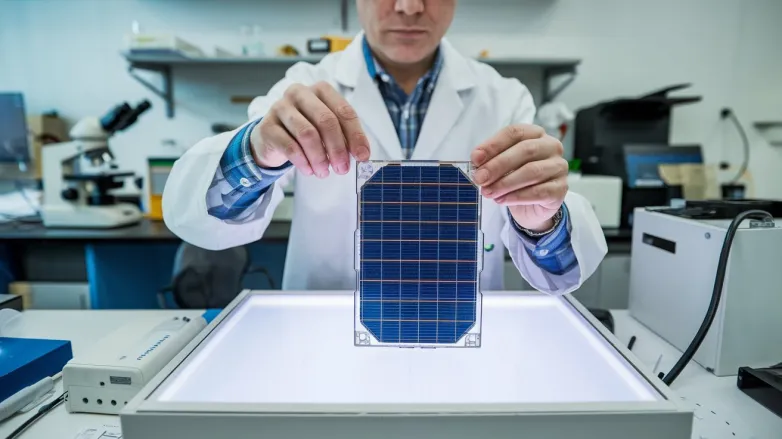Enecoat, Toyota Achieve Breakthrough in Solar Cell Efficiency
- EneCoat and Toyota’s groundbreaking solar cell achieves 30% efficiency, merging perovskite with silicon — a leap towards high-tech, sustainable automotive energy solutions!

EneCoat Technologies, in collaboration with Toyota Motor Corporation, has achieved over 30% conversion efficiency with a 4-terminal tandem solar cell that combines perovskite and crystalline silicon. This milestone highlights the companies' strengths in perovskite solar cell research and aims to accelerate the adoption of high-efficiency solar technologies. A significant improvement in infrared transmittance to 81% was also noted, enhancing the cell's application potential in automotive settings.
Additionally, the joint effort produced a flexible, film-type perovskite solar cell with a notable 22.4% efficiency, suitable for curved vehicle designs. By integrating this with a crystalline silicon cell, they reached a combined efficiency of 30.4%. Research will continue to scale up the technology for larger modules, building upon these promising results.
How does EneCoat and Toyota's tandem solar cell advance automotive solar technology?
- Innovative Technology Combination: EneCoat and Toyota's tandem solar cell represents a cutting-edge combination of materials—perovskite and crystalline silicon—allowing for improved energy conversion efficiency compared to traditional solar cell technologies, which typically struggle to exceed 20% efficiency.
- Enhanced Efficiency for Automotive Applications: Achieving over 30% conversion efficiency is a significant breakthrough for automotive solar technology. This advancement means that solar panels integrated into vehicles can generate more energy, potentially powering auxiliary systems or even providing additional range for electric vehicles.
- Infrared Transmittance Improvement: The notable increase in infrared transmittance to 81% allows more sunlight to be converted into energy while minimizing heat absorption within the vehicle. This feature is particularly beneficial for maintaining comfortable cabin temperatures and reducing air conditioning load, thereby improving overall vehicle efficiency.
- Flexible Solar Cell Design: The creation of a flexible, film-type perovskite solar cell with 22.4% efficiency opens avenues for innovative designs in vehicle aesthetics and functionality. This flexibility allows for integration into various surfaces and configurations, accommodating the curvature of vehicle exteriors without compromising efficiency.
- Potential for Lightweight Applications: Due to the lightweight nature of the perovskite materials, these tandem solar cells can be effectively integrated into the design of vehicles without adding significant weight. This contrasts with traditional solar panels, which can be cumbersome and affect vehicle performance.
- Scalability for Mass Production: The ongoing research focusing on scaling up this technology for larger solar modules lays the groundwork for mass production. This could greatly enhance the availability of high-efficiency solar cells for both automotive and other renewable energy applications.
- Environmental Impact: Using solar energy in vehicles contributes to reducing carbon emissions, especially when integrated into electric vehicles. The advancements made by EneCoat and Toyota promote a more sustainable automotive industry by harnessing clean energy sources.
- Collaboration Advantages: The partnership between EneCoat and Toyota underscores the importance of cross-industry collaborations in fostering innovation. By combining expertise in solar technology and automotive engineering, they are positioning themselves at the forefront of renewable energy solutions in the transportation sector.
- Future Applications Beyond Automotive: While the immediate focus is on automotive applications, the advancements in tandem solar cell technology could also be adapted for use in buildings, portable devices, and other spheres where space-efficient, high-efficiency solar energy solutions are needed.
- Market Influence: As the demand for sustainable solutions in the auto industry rises, advancements like those from EneCoat and Toyota can help set new industry standards. High-efficiency solar technologies will likely lead to increased investment and development within the sector.
By marrying cutting-edge solar technology with automotive innovation, EneCoat and Toyota are paving the way for a greener, more sustainable future in transportation.
Also read

